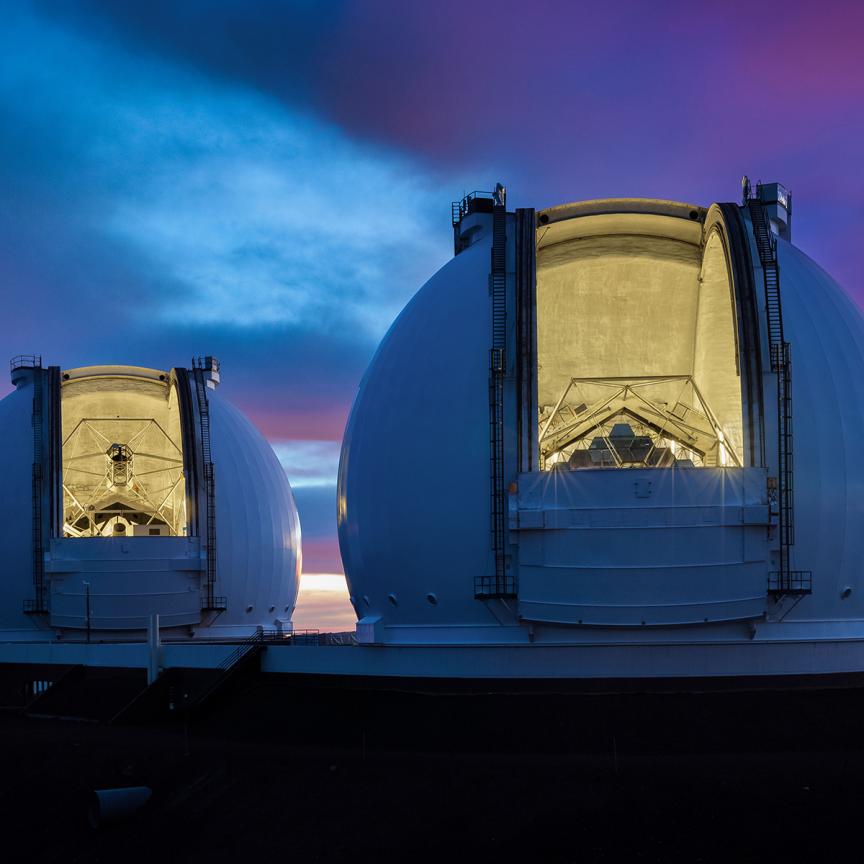In astronomy ground-based telescopes are often chosen for their convenience and cost-effectiveness over their space-based counterparts. They cost less as, not only are the materials used cheaper, they do not require expensive space launches. For a similar reason, they are also easier to repair and maintain.
However, the atmosphere that protects the Earth can interfere with a terrestrial telescope’s picture quality. This is a view held by Elon Musk, who has asserted: ‘We need to move telescopes to orbit anyway. Atmospheric attenuation is terrible.’ Musk’s company, SpaceX, has recently launched the Starlink satellite constellation to provide satellite internet access, and a number of astronomers are not altogether happy about it.
One group, in particular, has published a paper, 'Concerns about ground-based astronomical observations: a step to safeguard the astronomical sky'. It asks what effect satellites like the Starlink will have on ground-based astronomy and whether it could damage astronomical observation.
Making waves
In answer to the attenuation conundrum, the authors, astronomers Stefano Gallozzi, Marco Scardia and Michele Maris, suggest that ‘maybe Musk has never heard of adaptive optics’. These types of optics are warped to counteract the waves, turbulence and other disturbances in our atmosphere, and have been instrumental in allowing ground-based telescopes to overcome the effect of the atmosphere on observations. The paper cites telescopes such as the European Extremely Large Telescope (ELT), in particular, as using adaptive optics.
The European Southern Observatory (ESO), as well as the ELT, is also home to the Very Large Telescope (VLT), which consists of four-unit telescopes with main mirrors of 8.2m diameter, and four movable 1.8m diameter auxiliary telescopes. These can work in unison to form a giant interferometer, the ESO Very Large Telescope Interferometer (VLTI), allowing astronomers to see details up to 25 times finer than with the individual telescopes. The light beams are combined in the VLTI using a complex system of mirrors in underground tunnels, where light paths must be kept equal to distances less than 1/1,000mm over 100m.
This is clearly effective. Using the VLT, astronomers have recently captured the ‘unprecedented’ dimming of Betelgeuse, a red supergiant star in the Orion constellation. Images of its surface show not only the fading red supergiant, but also how its shape seems to be changing.
Star performer
The team, led by Miguel Montargès, an astronomer at KU Leuven in Belgium, has been observing the star with ESO’s VLT since December. The team also observed the star with Unit Telescope 3 of the VLT: the Spectro-Polarimetric High-contrast Exoplanet Research instrument (Sphere) in January last year, before it started to dim, allowing for ‘before’ and ‘after’ images, demonstrating changes to the star both in brightness and in apparent shape.
‘ESO’s Paranal Observatory is one of few facilities capable of imaging the surface of Betelgeuse,’ said Montargès. The instruments on ESO’s VLT allow observations from the visible to the mid-infrared, which means that astronomers can see both the surface of Betelgeuse and the material around it. ‘This is the only way we can understand what is happening to the star,’ added Montargès.
New details of the sun
Also taking advantage of adaptive optics is the National Science Foundation’s (NSF) Daniel K Inouye Solar Telescope (Dkist), which recently captured its first images, revealing ‘unprecedented detail’ of the sun’s surface. Dkist, on the summit of Haleakala, Maui, in Hawaii, is designed to enable a greater understanding of the sun and its impacts on our planet.
The first images show a groundbreaking close-up view of the sun’s surface. They detail a pattern of turbulent ‘boiling’ plasma that covers the entire sun. The cell-like structures are the telltale sign of violent motions that transport heat from the inside of the sun to its surface. Solar plasma rises in the centre of ‘cells’, cools, then sinks below the surface in dark lanes via convection.
The journey that sunlight makes through the Dkist is complex. Ten mirrors guide the 13kW of sunlight throughout the observatory, with each playing a role in delivering the sharpest images of the sun ever. The light enters the system through an aperture in the observatory dome. The first thing that sunlight strikes is a 4m mirror; the world’s largest for a solar telescope. This mirror can adjust its shape to compensate for warping of the mirror due to gravity and thermal effects. In an unusual design for large telescopes, the light is then reflected off to the side towards the secondary mirror, following the telescope’s ‘off-axis’ design. Unlike many telescopes, Dkist’s secondary mirror is at an angle to the first, rather than in the path of the incoming light. This is in an attempt to reduce as much scattered light as possible – vital to observe the elusive solar corona.
The secondary mirror directs the light downwards toward the Gregorian Optical System, which dictates the alignment of all other elements. From here, the light is fired through a system of mirrors that direct the beam through a fast flowing jet of air, called the air knife, and into the heart of the observatory – the instrument laboratory, also known as the Coudé Laboratory. The air knife makes it possible for light to enter this strictly controlled physics lab without disrupting the precise conditions, such as temperature, required within.
Once in the lab, sunlight can be directed to the deformable mirror. The surface of this extraordinary mirror changes its shape 2,000 times a second to counteract turbulence in the Earth’s atmosphere. The mirror is modified by a series of tiny pistons pushing on the surface. This ensures the light beam is as distortion-free as possible before hitting the scientific cameras.
Cooling is also vital to manage the 13kW of solar power that enters the telescope. Heat protection is provided by a specialised cooling system, including more than seven miles of piping to distribute coolant throughout the observatory, partially chilled by ice created on site during the night.
The mirror is made of glass-ceramic Zerodur from Schott. Zerodur has an extremely low thermal expansion, and is able to achieve very high precision for challenging high-tech applications, such as the VLT. It is an inorganic, non-porous lithium aluminium silicon oxide glass ceramic, characterised by evenly-distributed nano-crystals in a residual glass phase.
‘With the largest aperture of any solar telescope, its unique design, and state-of-the-art instrumentation, the Inouye Solar Telescope, for the first time, will be able to perform the most challenging measurements of the sun,’ Rimmele said. ‘After more than 20 years of work by a large team devoted to designing and building a premier solar research observatory, we are close to the finish line. I’m extremely excited to be positioned to observe the first sunspots of the new solar cycle just now ramping up with this incredible telescope.’
The telescope will work with space-based solar observation tools such as Nasa’s Parker Solar Probe (currently in orbit around the sun) and the European Space Agency/Nasa Solar Orbiter. The three solar observation initiatives will expand the frontiers of solar research and improve scientists’ ability to predict space weather.
Weather watch
France Córdova, director at NSF explained: ‘Since NSF began work on this ground-based telescope, we have eagerly awaited the first images. We can now share these images and videos, which are the most detailed of our sun to date. NSF’s Dkist will be able to map the magnetic fields in the sun’s corona, where solar eruptions occur that can impact life on Earth. This telescope will improve our understanding of what drives space weather and, ultimately, help forecasters better predict solar storms.’
Movements of the sun’s plasma are understood to twist and tangle solar magnetic fields. This can lead to solar storms that negatively impact technology in everyday life. For instance, during Hurricane Irma in 2017, the National Oceanic and Atmospheric Administration reported a simultaneous space weather event that brought down radio communications used by first responders, aviation and maritime channels for eight hours on the day the hurricane made landfall. What stands out with Dkist, is its ability to measure and characterise the sun’s magnetic field in greater detail to determine the causes of potentially harmful solar activity.
Matt Mountain, president of the Association of Universities for Research in Astronomy, which manages Dkist, said: ‘On Earth, we can predict if it is going to rain pretty much anywhere in the world very accurately, and space weather just isn’t there yet. Our predictions lag behind terrestrial weather by 50 years, if not more. What we need is to grasp the underlying physics behind space weather, and this starts at the sun, which is what the Inouye Solar Telescope will study over the next decades.’
Thomas Rimmele, director of Dkist, added: ‘It’s all about the magnetic field. To unravel the sun’s biggest mysteries, we have to not only be able to clearly see these tiny structures from 93 million miles away, but very precisely measure their magnetic field strength and direction near the surface, and trace the field as it extends out into the million-degree corona, the outer atmosphere of the sun.’
By providing a better understanding of the origins of potential disasters in this way, the telescope can help governments and utilities to better prepare for inevitable future space weather events.
Five star
Returning to the ELT mentioned in the astronomers’ paper, this is Schott’s next project. The company is manufacturing the mirror substrate components for the telescope, which is on the Chilean Cerro Armazones. This will feature a primary mirror 39m in diameter, and Schott has already delivered segments for the fourth mirror of the telescope optics, as well as two mirror substrates in the 4m class for the secondary and tertiary mirrors. It is starting a series production of more than 900 mirror substrates for the segmented primary mirror.
The telescope’s five-mirror design is a mobile construct equipped with a mirror substrate of 1.95mm-thick Zerodur glass-ceramic. It is designed to be able to perfectly ‘smooth’ starlight.
The mirror substrate is composed of six individual glass-ceramic segments that are arranged in a ‘petals’ formation. The 2.4m adaptive mirror area is supported by around 5,600 actuators, making it the largest of its kind. During operation, the actuators distort the mirror surface – mounted on magnetic fields, with virtually no contact – thousands of times per second.
This is ideal in compensating for the influence of air disruptions. An artificial star, simulated with six lasers in the atmosphere, is used to calibrate the apparatus.
The company says that images taken by the earth-bound mega-telescope will be 15 times sharper than those taken by the Hubble Space Telescope. The ELT is due to be operational in 2025.


